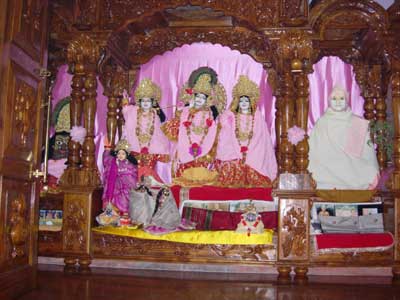|
Çré Gétopaniñade Ätma-nivedana Self-surrender in Bhagavad-gétä
by Çré Srimad Bhakti Prajìäna
Keçava Gosvämé Mahäräja  [NOTE: This page uses Balarama font (available here) for better transliteration of Sanskrit into English] Arya-åñis have glorified Çrémad Bhagavad-géta as Upaniñad-cüòämaëi, the crest
jewel of all the Upaniñads. In comparison to other Upaniñads,
Çré Gétä specifically establishes
Bhagavän's lélämayatva (being endowed with lélä). Also, in the verses that sing the glories of Gétä (Gétä-mähätmya), it has been described as the essence of all Upaniñads. sarvopaniñado gävo dogdhä gopäla-nandana pärtho vatsaù su-dhér bhoktä dugdhaà gétämåtaà mahat “This Gétopaniñad, Bhagavad-gétä, the
essence of all the Upaniñads, is just like a cow,
and Lord Kåñëa, who is famous as a cowherd boy, is milking this cow. Arjuna is just like a calf, and learned scholars and
pure devotees are to drink the nectarean milk of Bhagavad-gétä.”
(Gétä-mägätmya 6) The speaker of Gétä, which is a part of Mahäbhärata, is Devaké-nandana Çré Väsudeva. However, in the above verse it
is said ‘dogdhä gopäla-nandana’ i.e. the milkman (speaker) is Goparäja-nandana Kåñëa. It is thus
clearly understood that Vrajendra-nandana Våndävanabihäri Çré Kåñëa alone is
the speaker of Çré Géta. Although He has spoken Géta in His Väsudeva form, His own statements have revealed His real rasamaya-svarüpa. Our gosvämés have indicated in their
literatures that another name of Mother Yaçodä is Devaké, and Devaké-putra (the
son of Devaké) is indeed another name of Yaçodä-putra. Although Devaképutra
Väsudeva is apparently the speaker of Çré Gétä, Çré Nanda-nandana Kåñëa is the actual speaker. By discussing the beginning, the conclusion, and so on of Çré Gétä, it can be understood
that Çré Kåñëa alone is the Supreme (parama-deva), and the topmost worshipable reality. He is worshiped only by bhakti, and prema-bhakti is the climax of that
worship. Now we will discuss the nature and development of ätma-nivedana explained in Çré Gétä. From an external point
of view, the instructions of Gétä are universal. From karmärpaëa
(offering the results of activities) up to çaraëägati (surrender) and ätma-nivedana (full
self-surrender) —everything related to bhakti is sung there in condensed form. Ätma-nivedana is of two
kinds—ordinary (common) and extraordinary (uncommon). In Çré Bhakti-sandarbha, Çréla Jéva
Gosvämépäda has classified these two types of ätma-nivedana: ordinary ätma-nivedana is bhävam vinä, devoid of any sthäyi-bhäva
or permanent mellow, and extraordinary ätma-nivedana
is bhäva vaiçiñöena ca, endowed with specific bhäva or permanent mellow. ‘Tadetätma-nivedanam bhävam vinä bhäva vaiçiñöena ca dåçyate’ (Bhakti-sandharbha 309 anuccheda). To illustrate the first type, Çréla Jéva Gosvämépäda has quoted the following verse from Çrémad-Bhägavatam (11. 29.34): martyo yadä
tyakta-samasta-karmä niveditätmä vicikérñito me tadämåtatvaà pratipadyamäno mayätma-bhüyäya ca kalpate
vai “A person who gives up all
fruitive activities and offers himself entirely unto Me, eagerly desiring
to render service unto Me, achieves liberation from birth
and death and is promoted to the status of sharing My own
opulences.” To illustrate the second type, bhäva-viçiñta
ätmanivedana, he has quoted the statement of
Çré Rukmiëédevé in the verse: tan me bhavän khalu våtaù
patir aìga jäyäm ätmärpitaç ca bhavato 'tra
vibho vidhehi mä véra-bhägam abhimarçatu
caidya äräd gomäyu-van måga-pater balim
ambujäkña “Therefore, my dear Lord, I have
chosen You as my husband and I surrender myself to You.
Please come swiftly, O Almighty One, and make me Your
wife. My dear lotus-eyed Lord, let Çiçupäla, who is like a
jackal stealing the property of a lion, never touch the hero's
portion.” (SB 10.52.39) Here the word bhäva means sambandha, relationship in terms of räganuga
bhakti in däsya-rasa,
sakhya-rasa and so on. According to Bhakti-sandarbha verse 309, ‘bhäva vaiçiñtena’
refers to four bhävas--däsya,
sakya, vätsalya, and madhura bhäva. The ätma-nivedana at the lotus
feet of Bhagavän which is endowed with any one of these four bhävas or specific relationships
is bhäva-yukta ätmanivedana, and the ätma-nivedana that is performed at the lotus feet of Bhagavän before the
awakening of any of these four bhävas is called bhäva-héna
ätma-nivedana. Bhäva-héna ätma-nivedana is visible in
the life of Çré Bali Mahäräja, and Çréla Jévapäda has shown this elsewhere in
his Sandarbha. Çré Bali
Mahäräja's däsya is bhävahéna däsya, devoid of any bhäva or sambandha, and is not räganuga-däsya. The most confidential and topmost instruction of Gétä is: sarva-dharmän parityajya mäm ekaà çaraëaà vraja ahaà tväà sarva-päpebhyo mokñayiñyämi mä çucaù “Completely abandoning all bodily
and mental dharma, such as varëa and äçrama, fully surrender
to Me alone. I shall liberate you from all reactions to your
sins. Do not grieve.” (BG 18.66) The çloka of Çrémad-Bhägavatam beginning ‘martyo yadä
tyakta-samasta-karmä,’ quoted by Çréla Jéva Gosvämé as an example of bhävahéna ätma-nivedana, and the cloak ‘sarva-dharmän parityajya,’ which is the topmost instruction of Gétä, convey the same meaning.
Moreover, ‘ahaà tväà
sarva-päpebhyomokñayiñyämi mä çucaù’ is only the explanation of the words ‘vicikérñito me’ (desirous of
doing something
special) clearly instructs bhävahéna
ätmanivedana for the common masses. Now we have to consider whether or not the indication or hint of
bhäva-yukta ätma-nivedana is given in Gétä. An intelligent lover, who is the object of love for everyone,
will speak to common people in a general way about affectionate service to him.
If his beloved is also present among the general people, then, in midst of his
general topics, he will hint to his beloved in a hidden manner about how to
please him in a special way. Although ordinary people will be unable to
understand such hints, those who are extraordinarily dear to him will certainly
be able to comprehend them. Similarly, vidagdhacüòämaëi, the crest jewel of intelligent lovers, Gopäla-nandana Çré Kåñëa, while aiming at ordinary people, has
given hints about extraordinary service or extraordinary ätmanivedana (bhäva-yukta ätma-nivedana) for those
who are so desirous. What to speak of karmis (fruitive workers), even jïäna-miçra-bhaktas
cannot understand such hints. On the other hand, bhaktas who desire an extremely
intimate relationship with Him in rägänuga-bhäva
not only comprehend His hints about bhäva-yukta ätma-nivedana, but also
realize His clear instructions on the subject. In the Tenth Canto, Çré Rukmiëé-devé prays to Çré Kåñëa in her
letter: “Tan me bhavän khalu våtaù
patir aìga jäyäm…, I accept You as my husband and fully dedicate myself (ätma nivedana) at Your lotus feet.” Here, ätmanivedana is performed by possessing käntä-bhäva, a conjugal relationship, in the heart. Bhäva-yukta ätma-nivedana is
clearly expressed in Bhagavad-gétä (10. 9-10) and (11.44). There, Çré Bhagavän has said: mac-cittä mad-gata-präëä bodhayantaù parasparam kathayantaç ca mäà nityaà tuñyanti ca ramanti ca “Those whose minds are absorbed in
Me and whose lives are wholeheartedly devoted to My
service, derive great satisfaction and bliss from constantly
enlightening one another about My tattva and performing kértana of My name, form, qualities and pastimes.” (Gétä
10.9) teñäà satata-yuktänäà bhajatäà préti-pürvakam dadämi buddhi-yogaà taà yena mäm upayänti te “Upon those who perform bhajana to with love, yearning for My eternal association, I bestow the
transcendental knowledge by which they can come to Me.” (Gétä 10.10) Here, Kåñëa is saying: “Those whose minds and lives are devoted
to Me and who always meditate on Me, always speak about Me and derive
satisfaction in Me alone. Their minds feel relaxation and comfort only by thinking
about Me, and they are constantly desirous of perpetual union with Me. I bestow
upon such bhaktas buddhi-yoga, transcendental intelligence and knowledge by which they can
attain Me.” Gétä commentators, including Çréla
Çrédhara Swämépäda, explained these two çlokas from the perspective of common people only. However, vidagdha-çiromaëi Çré Kåñëa
cannot check Himself from speaking the core instructions, even in the midst of
speaking His general instruction. That essential instruction is to render viçrambha-seva, intimate
loving service unto Him. These commentators give a general explanation of the
component ‘ramanti ca’ in their purport which is similar to the explanation of ‘tuñyanti ca’. Thus, there remains no specific
significance to the phrase ‘ramanti ca’. However, unless there is a specific meaning to these words,
there would have been no reason for Kåñëa to use them. Çréla Baladeva
Vidyäbhüñaëa Prabhu and Çréla Viçvanätha Cakravarté Öhäkura have therefore excluded
the general meaning of ‘ramanti ca’ and have only accepted its specific meaning through its verbal
root (which carries its innate meaning). Ram-dhätu
i.e. the verbal root ‘ram’, means ‘kåédä’, sport or play. Use of the verbal root ‘ram’ not only indicates bhäva-yukta ätma-nivedana, but it
indeed also indicates the topmost among all bhävas-- madhura-bhäva-yukta
ätma-nivedana. Çréla Baladeva Vidyäbhüñaëa Prabhu has said in his commentary: ‘ramanti ca yuvati-smita-kaöakñädiñu eva yuvänaù.’ Only that ätma-nivedana that is characterized by accepting Bhagavän as the object of madhura- préti is referred to
here. That känta-bhäva (conjugal relationship) has the attributes of smiles, sidelong glances and so on. Çréla
Jéva Gosvämépäda quotes a part of Çré Rukmiëédevé's letter (tan me bhavän khalu våtaù patir…), as an example of bhäva-yukta
ätma-nivedanam, which has the same meaning as
the inner meaning of the ‘ramanti ca’ portion of the Gétä's
çloka. Çréla Viçvanätha Cakravarté Öhäkura gives a similar meaning for
‘ramanti ca’. He explains
that rägänugabhakti is
expressed in these words of Bhagavän. The only satisfaction and delight of the ananyä bhaktas is the
performance of bhakti. This is the secret. Even in the stage of sädhana they attain satisfaction
by the unobstructed performance of bhajana. While meditating on their future stage of perfection, sädhya-daçä, they experience delight.
In other words, they enjoy with their Prabhu, Kåñëa, within their minds. In Arjuna's words: iteva putrasya sakheva
sakhyuù priyaù priyäyärhasi deva
soòhum “O Deva, just as a father forgives
his son, a friend tolerates a friend, or a lover excuses his
beloved, please forgive all my offences.” (Gétä 11.44) Here, the subject of ätma-nivedana
that is endowed with däsya,
sakhya, vätsalya, and madhura bhävas, has been clearly
expressed. ‘Dadämi buddhi-yogaà taà yena
mäm upayänti te.’ Here, the prominent mahäjanas, Çréla Baladeva Vidyäbhüñaëa Prabhu and Çréla Cakravartépäda,
express that ‘buddhi-yoga’ is suggestive only of bhäva-yukta
sädhana, (sädhana endowed with bhäva [relationship]). Çréla Baladeva Vidyäbhüñaëa Prabhu states in his commentary: “I
am svabhakti-rasika, the enjoyer of the rasa derived from the happiness of My own bhakti, and I bestow upon My devotees
that buddhi-yoga by
which they attain Me. I inspire their buddhi in such a manner that they can understand Me, who am replete
with unlimited qualities and majesties. Thus, they can attain Me by their
worship.” Çréla Viçvanätha Cakravarté Öhäkura has said in his purport to
this verse: “I bestow upon them buddhi-yoga. I inspire that buddhi-yoga
within their hearts’ tendencies. That buddhi-yoga cannot be achieved by
individual efforts, nor can it be obtained from anyone else. It is bestowed by Me
alone, and only such bhäva-yukta sädhakas can receive it. This is the meaning of Kåñëa’s words.”
![[BVML Home Page]](../grfx/bml_logo.gif)
 Sri Srimad Bhakti Prajnana Kesava Goswami Page |
